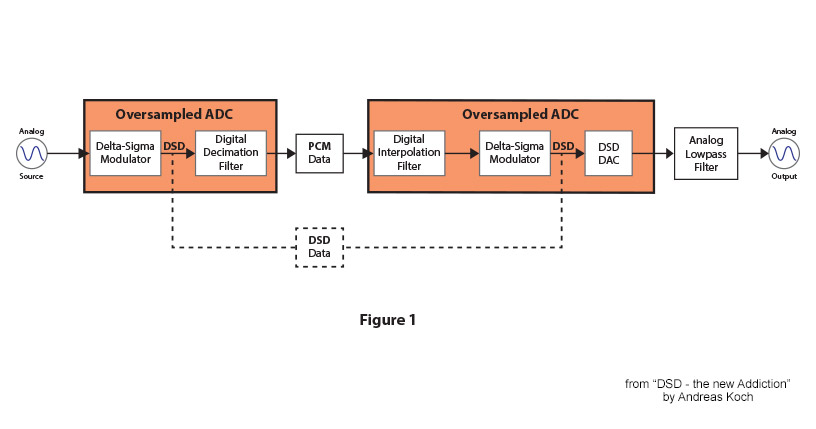First comment is of John Siau:
Where does Benchmark stand on DSD vs. PCM, and why?
1. Benchmark recognizes that DSD (64x and higher) has significant advantages over 44.1/16 PCM.
2. Benchmark recognizes that high-resolution PCM (96/24 and higher) has significant advantages over 44.1/16 PCM.
3. Benchmark’s measurements and calculations show that the performance of 64x DSD is almost identical to the performance of 20-bit 96 kHz PCM (the in-band SNR of 64x DSD is about 120 dB). 64x DSD does not have any time-domain, frequency domain, or linearity advantage over 96 kHz PCM. DSD marketing materials have been very misleading.
4. 24-bit 96 kHz PCM has a 24 dB noise advantage over 64x DSD (144 dB vs. 120 dB), but this 24 dB noise difference is completely masked by the noise produced by other components in our recording and playback systems, and by the noise limitations of our recording and listening spaces.
5. Benchmark recognizes that 64x DSD and 96/24 PCM formats outperform most of the recording and playback chain. Bandwidth of either digital transmission system meets or exceeds the bandwidth of our microphones, amplifiers, and speakers. Likewise, the SNR of either digital transmission system meets or exceeds the noise performance of microphones, microphone preamplifiers, and power amplifiers. In addition, these digital transmission systems both exceed the performance of most A/D and D/A converters. 64x DSD and 96/24 PCM are not the factors limiting the performance of our audio systems. Focusing on DSD vs. PCM will distract us from much bigger issues in the recording and playback chain. Any sonic advantage of one digital system over the other will be very small when compared to improvements that can be made in other parts of the signal chain.
6. 64x DSD and 96/24 PCM both offer excellent sonic performance as distribution formats. PCM is more compact, but DSD provides better copy protection (a frustration to those of us who use music servers, but an important consideration for copyright holders).
7. Every A/D and D/A converter that Benchmark has produced uses Sigma-Delta conversion with equally-weighted 1-bit conversion elements. Benchmark never used multi-level conversion because of the THD issues caused by the linearity errors that are common to all multi-level systems. Benchmark has always placed high priorities on THD and linearity, at the expense of SNR. Sigma-delta 1-bit DACs tend to produce more noise than multi-level systems (such as ladder DACs), but the 1-bit systems achieve near-perfect linearity, which in our opinion is much more important than SNR. Benchmark has overcome the noise limitations of 1-bit conversion through the use of parallel 1-bit conversion systems. Our DAC2 sums the outputs of four balanced converters. Each of these four converters has sixteen equally-weighted balanced 1-bit converters (for a total of 64) that are summed together to improve the SNR of the system. These 64 1-bit converters can be driven from a 32-bit PCM signal, or from a 1-bit DSD signal. Either way, the performance is nearly identical, and none of the multi-bit THD issues exist. In this sigma-delta configuration there is almost no difference between the in-band performance of PCM vs. DSD. The only measurable difference at the output of the DAC2 is that 64x DSD signals produce about 8 dB more noise in-band than 96/24 PCM (due to the SNR limitations of DSD). Ultrasonic noise is not an issue at the output of the DAC2 because we are careful to remove the ultrasonic noise produced by DSD noise shaping. These same filters also remove the ultrasonic images that are always produced by D/A conversion (DSD or PCM).
8. The ultrasonic noise produced by DSD noise shaping must be removed after D/A conversion. It cannot be removed from the DSD signal before D/A conversion. This noise is due to the 6-dB SNR of the 1-bit DSD transmission system. Aggressive noise-shaping must be used in the DSD A/D, and at least once more in the mastering process. This noise-shaping is used to achieve an excellent SNR in the audible band by moving most of the 1-bit quantization noise to ultrasonic frequencies. Each time this process is applied, the quality of the DSD audio degrades (noise and distortion both increase). For this reason, the quality of DSD degrades very quickly in the mixing and mastering process. DSD has produced impressive results when the mixing and mastering processes have been omitted from the signal chain. To date, most of the DSD vs. PCM listening tests have omitted these processing steps. Unfortunately very few recordings can be produced without some mixing, editing, and mastering. Cascaded DSD noise-shaping processes should be avoided. For this reason, Benchmark does not recommend recording and mixing in DSD.
9. The 24-dB noise advantage that 24/96 PCM has over 64x DSD begins to become significant in the mixing and mastering processes. In terms of in-band noise, each DSD noise-shaping process is equivalent to at least 16 cascaded 24-bit dither processes. In terms of distortion, there is no comparison; the DSD noise-shaping process adds distortion while the PCM dithering process is distortion-free.
10. If the ultrasonic noise of DSD is not removed after D/A conversion, it will usually cause distortion in the playback system. The slew-rate limitations of most power amplifiers will fold the ultrasonic noise into the audible band causing distortion that is not harmonically related to the music. If the power amplifier has sufficient slew rates to pass the ultrasonic frequencies, similar problems will occur in the speakers. For these reasons, the ultrasonic noise must be removed from a DSD source after D/A conversion or before amplification.
11. Benchmark introduced 64X DSD on the new Benchmark DAC2 converter family. This gives our customers the ability to play DSD recordings in native format. Existing DSD recordings should not need to be converted to PCM to be enjoyed on a Benchmark converter.
12. Currently there is no practical way to play SACD disks through a high-quality outboard converter. SACD copy protection holds most existing DSD recordings captive to the limited quality of the low-cost conversion systems built into SACD players. It is our hope that many of the fine recordings that exist on SACD disks will be released for purchase as DSD downloads.




 LinkBack URL
LinkBack URL About LinkBacks
About LinkBacks

 Citar
Citar













 .
.







